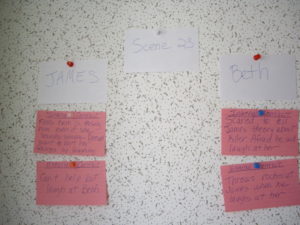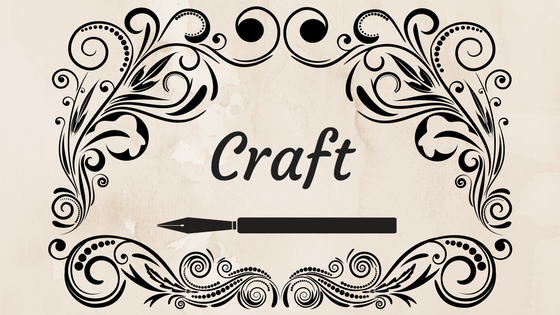by Lisanne Harrington
As I told y’all last time, I come from a family of writers. Mom writes middle-grade historical fiction and my oldest daughter writes for TV. I write paranormal and murder mysteries. Each of us uses a different method to begin our stories: Mind Mapping, which we covered in Part One, Index cards and what I call Mind Melding, which I cover in Part Three.
Index Cards
Index cards can be very useful. You can write down individual thoughts and ideas, create scenes, develop character traits, etc. Whatever you want, whatever means something to you. Best of all, there’s no right or wrong way to use them.
Let’s use the same scene from Moonspell that we did when we developed the Mind Map. As you recall, James and Beth live in Wolf Creek, where a serial killer lurks in the shadows, killing at random. Only the cousins know the truth, but no one will believe them. In this scene, Beth tells James that the killer is a werewolf.
The Mind Map focused on Plot, Character, Setting and Timeline. You can also include Conflict, Resolution, Dialog (remembering the four basic building blocks of a good scene: Action, Dialog, Conflict, Resolution), basically anything you can think of. For our purposes, let’s use Character, Setting, Timeline, Conflict and Resolution.
Index cards come in a plethora of colors, so before we begin, let’s create our Rainbow o’ Cards. I suggest using the lighter colored cards, as the neon packs can be a little hard to read. For those of you who might find yourselves distracted by all the pretty colors <SKWERL!> plain white cards work just fine.
- Character – Blue – James
- Character – Yellow – Beth
- Pink – Conflict
- Green – Resolution
- Lavender – Setting
- White – Timeline
Character
Let’s start with James. He’s fourteen, loves reading, NPR, his poster of the Kardashian sisters in white bikinis, and video games. While he would never admit it, he thinks Beth is pretty cool. He loves to tease her about her freckles, frequently asking her to get him a Sharpie so he can play Connect-the-Dots on her nose. His family still calls him “Jaime,” which he hates but is resigned to.
Beth is his eleven-year-old cousin. She resembles the Wendy’s Hamburger Girl, with her braids all askew and her embarrassingly huge amount of freckles. Never shy about voicing her opinion, she thinks James is the greatest thing since chili fries and doesn’t really mind all his teasing. She just never wants him to know that.
Method
We’ll need one card for each of James’s personality traits, for a total of five: James is (1) fourteen, (2) loves reading and NPR, his poster of the Kardashian sisters in white bikinis, and video games. (3) While he would never admit it, he thinks his cousin Beth is pretty cool. (4) He loves to tease her about her freckles, frequently asking her to get him a Sharpie so he can play Connect-the-Dots on her nose. (5) His family still calls him “Jaime,” which he hates but is resigned to.
Each number would go on a separate card. You could separate his traits further, such as his love of reading and NPR, but I think of them as linked together so I would only need one card. But that’s the fun of this system—you can do it any way you please, and no one can say it’s wrong.
Now we grab our yellow cards and work on Beth. She’s (1) eleven. (2) She resembles the Wendy’s Hamburger Girl, with (a) her braids all askew and (b) her embarrassingly huge amount of freckles. (3) Never shy about voicing her opinions, (4) she thinks James is the greatest thing since chili fries and (5) doesn’t really mind all his teasing. She just never wants him to know that.
“What’s that?” you ask. “What’s up with the “a” and the “b”?”
This is just another method you can use. Sub-traits like hair and freckles are how she looks like the Wendy’s girl, so they can go with that trait. Or not. You can leave them linked together like reading and NPR for James, or you can separate them if it makes more sense to you.
So tack these up vertically on the wall, pull out the pink cards, and move on to Conflict.

Conflict
Each character has Internal and External Conflict. Beth’s Internal Conflict is that she is scared to tell James her theory about the killer, for fear that he will laugh at her. James’s Internal Conflict is that while Beth seems sincere, he can’t help but feel that she’s pulling his leg. He doesn’t want to laugh, but he just can’t help himself. And of course, the External Conflict is that he does laugh at her. She gets offended, throws rocks at his head and storms off.
Here it gets a little tricky. You could pull out your markers and pick four easy-to-read-through colors and highlight each character in a different color, then each character’s Internal Conflict in a third color and the External Conflicts in the fourth. But my favorite way is to use the white cards to name each character and then put everything for that character underneath it. Much easier, isn’t it?
With me so far?

Resolution
Using the green card, jot down the scene’s Resolution. James apologizes for laughing and hurting Beth’s feelings. Everything is fine. For now.
Wouldn’t want to spoil the book’s surprise, would we? 😀
Setting & Timeline
Our lavender card gives us the Setting (pitcher’s mound on the baseball field) and we’d jot down the date for this scene on a white card.
And there you have it. Do this for each scene and when you are done, the story will practically write itself!

Next time, we’ll discuss my personal favorite method to begin a story—the Mind Meld.
***
 After sixteen years as a paralegal, I staged a coup and left the straight-laced corporate world behind forever. I now pander to my muse, a sarcastic little so-and-so who delights in getting the voices in my head to either all speak at once in a cacophony of noise or to remain completely silent. Only copious amounts of Diet Cherry Dr. Peppers and hamburgers will ensure their complicity in filling my head with stories of serial killers, werewolves, and the things that live under your bed.
After sixteen years as a paralegal, I staged a coup and left the straight-laced corporate world behind forever. I now pander to my muse, a sarcastic little so-and-so who delights in getting the voices in my head to either all speak at once in a cacophony of noise or to remain completely silent. Only copious amounts of Diet Cherry Dr. Peppers and hamburgers will ensure their complicity in filling my head with stories of serial killers, werewolves, and the things that live under your bed.
I live in SoCal, in the small town I fashioned Moonspell’s Wolf Creek after, with my beloved husband and persistently rowdy, always-has-to-have-the-last-word Miniature Pinscher, Fiona.
*O.C. Writers is a participant in the Amazon Services LLC Associates Program, an affiliate advertising program designed to provide a means for us to earn fees by linking to Amazon.com and affiliated sites. By clicking on the book links anywhere on this site, we earn a small commission from your purchase.



I know loads of writers who use this method. I saw one who even used the sliding glass doors to his patio to display the index cards. When he removed them, I knew the book was finished. You can get a good size pack of index cards at the $.99 store. Thanks for all that tips, Lisanne.
Another good job! I tried using the card method when I first started writing, but it didn’t work for me. However, I do have author friends who swear by it, as they are not ‘outliners”, either. The ‘mind-map” works best for me, but the downside is that you either have to have a large office, and a table besides your desk for the drawing pads and pens, or clutter up the dining room table…which I do. LOL Looking forward to your next lesson.